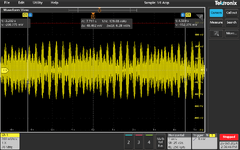Quant01
Newbie

Hi all,
Recently, I posted the following message on another forum and was advised to ask around in a DSP forum :
"I've been using an arbitrary waveform generator for one of my projects, and specifically, I'm using a DDS option on that AWG (the waveform generator is an M4i6621x8 from Spectrum Instrumentation). Essentially, I'm sending asking the DDS to output a sum of RF sine waves, all of them being on the order of 10s of MHz, with a delta in frequency of at least 1Mhz. However, on the output signal, if I ask for a certain amount of sin waves (usually 5 or more), I start observing a modulation of the amplitude of frequency a few hundred mHz (orders of magnitude away from my input frequencies). The modulation is sinusoidal.
My questions are : why does this happen and how can I remove this feature ? I would expect some MHz beating because of how sum of sine functions work, but definitely not mHz.
Some additional information :
-the frequency resolution of the DDS is about 290 mHz, so this value seems to fit with the observed beating, but I fail to see how this could be related to the issue.
-I didn't notice such beating when using less than 5 frequencies as an input.
-I am using a ZHL-1-2W+ power amplifier at the output of the AWG, which is then connected to an acousto optic deflector (a device that diffracts a laser beam according to input frequencies). The amplitude modulation becomes visible on camera based on the intensity of the diffracted beams."
If anyone knows how to solve this issue or has any idea, it would be greatly appreciated.
Thanks in advance.
Recently, I posted the following message on another forum and was advised to ask around in a DSP forum :
"I've been using an arbitrary waveform generator for one of my projects, and specifically, I'm using a DDS option on that AWG (the waveform generator is an M4i6621x8 from Spectrum Instrumentation). Essentially, I'm sending asking the DDS to output a sum of RF sine waves, all of them being on the order of 10s of MHz, with a delta in frequency of at least 1Mhz. However, on the output signal, if I ask for a certain amount of sin waves (usually 5 or more), I start observing a modulation of the amplitude of frequency a few hundred mHz (orders of magnitude away from my input frequencies). The modulation is sinusoidal.
My questions are : why does this happen and how can I remove this feature ? I would expect some MHz beating because of how sum of sine functions work, but definitely not mHz.
Some additional information :
-the frequency resolution of the DDS is about 290 mHz, so this value seems to fit with the observed beating, but I fail to see how this could be related to the issue.
-I didn't notice such beating when using less than 5 frequencies as an input.
-I am using a ZHL-1-2W+ power amplifier at the output of the AWG, which is then connected to an acousto optic deflector (a device that diffracts a laser beam according to input frequencies). The amplitude modulation becomes visible on camera based on the intensity of the diffracted beams."
If anyone knows how to solve this issue or has any idea, it would be greatly appreciated.
Thanks in advance.



